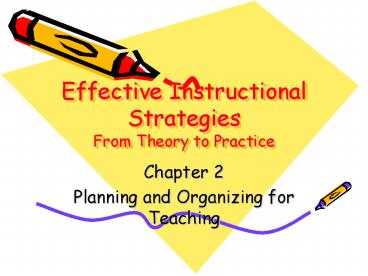Effective Instructional Strategies From Theory to Practice - PowerPoint PPT Presentation
1 / 18
Title:
Effective Instructional Strategies From Theory to Practice
Description:
Effective Instructional Strategies From Theory to Practice Chapter 2 Planning and Organizing for Teaching * * * * * * * * * * * * * * * * * * A Model of Teaching Step ... – PowerPoint PPT presentation
Number of Views:555
Avg rating:3.0/5.0
Title: Effective Instructional Strategies From Theory to Practice
1
Effective Instructional StrategiesFrom Theory to
Practice
- Chapter 2
- Planning and Organizing for Teaching
2
A Model of Teaching
- Step 1-Diagnose the learning situation
- Step 2-Plan the course
- Step 3-Plan the instruction
- Step 4-Guide learning activities
- Step 5-Evaluate learning
- Step 6-Reflect
- Step 7-Follow up
3
Categories of Classroom Time
- Mandated time
- 7 hours a day
- 180 days /year
- Allocated time
- Time for each activity
- Instructional time
- Time it should take
- Time on task
- Time students are engaged
- Academic Learning Time
4
Time Wasters
- Starting classes
- Excessive use of films
- Discipline time
- Early finishes
- Extracurricular activities
5
Curriculum Defined
- all the planned and unplanned learning
experiences that students undergo while in a
school setting. - Sometimes the gap between the curriculum
guidelines and what is actually taught in
classroom. - Its at this point that Curriculum Mapping steps
in..
6
Benefits of Curriculum Mapping
- Detect and fix curriculum gaps
- Address repetitions in the curriculum
- Refine scope and sequence connections
- Identify potential areas for curriculum
integration - Better alignment of assessments with
state/district standards - Upgrade teaching strategies and materials
7
Backward Design Model (Wiggins and McTighe, 2005)
Begin by identifying the desired results and then
work backwards to develop instruction.
UbD Understanding by Design
8
Curriculum Reform Efforts
- Subject-centered v. student-centered curriculum
- Brain-based learning
- Hydration and learning
- Environmental factors
- Integrated learning
9
Subject-centered v. Student-centered curriculum
- Student-centered
- Centered on Learner Needs
- Determination of Subject Matter
- Centered on Cooperative
- Emphasis on Variability in
- Exposure to Learning
- Emphasis on Skills
- Emphasis on Immediate
- Meanings of Learning
- Emphasis on Indirect Strategies
- Subject-centered
- Focus on Subject Matter
- Centered on Subjects
- Subject Matter Organized by
- Teacher before Instruction
- Emphasis on Facts, Knowledge,
- and Information
- Generally Lower-Level Learning
- Emphasis on Uniformity of
- Exposure
- Emphasis on Direct Strategies
10
Curriculum integration
- Provides holistic, problem-based learning that
leads to a greater ability to make connections
and to solve problems. - Models for implementing integrated curriculum
(Ross and Olsen, 1993) - Single-Subject Integration
- The Coordinated Model
- The Integrated Core Model
- The Integrated Double Core Model
- The Self-Contained Core Model
Pg. 37
11
The well-planned curriculum will
- reflect the needs of students, society, and the
subject itself. - be structured around state standards (sometimes
called skills, outcomes, or benchmarks)
12
Instructional Planning
- Teachers are responsible for
- organizing the state-mandated curriculum-or
mastery curriculum. - planning generic lessons.
- planning enrichment activities.
13
Instructional Planning (cont.)
- 60-75 of instructional time should be allocated
to the mastery curriculum (Glatthorn, 1987). - Generic lessons comprise interpersonal and
intrapersonal attitudes, beliefs, skills, and
knowledge - Enrichment activities include things that are
nice to know but not essential for all students.
14
Planning Your Course
- What major topics (chapters) will be covered? Can
you justify your selections? - Should the class textbook content (chapters) be
supplemented? - How should the topics (chapters) be grouped to
form units of study? Why? - In what sequence should the planned units be
taught? Why? - How much emphasis should each unit receive? In a
35-week course, how much time should each unit
receive (in weeks and fractions of weeks)?
15
Course Plan
- The course plan should be flexible.
- Analyze textbook to determine important content.
- Plan for time allotments based on method and
procedure. - Include extra time in the plan-for review,
enrichment, or instruction.
16
Differentiated Instruction
- Instructional approaches should vary and be
adapted in relation to individual and diverse
students in the classroom. - Teachers can differentiate at least 4 classroom
elements
- content
- process
- products
- learning environment
17
Eight Areas of Multiple Intelligences
- Linguistic
- Logical-mathematical
- Spatial
- Bodily-kinesthetic
- Musical
- Interpersonal
- Intrapersonal
- Naturalist
- (Gardner, 1983)
Pg. 51
18
Technology in the Classroom
- Integrate technology literacy into school
curriculum. - Take advantage of students familiarity with
technology. - Computer-based instructionCBIto support and
enhance instruction. - Immediate access to information increases
interest in content. - Multi-media resources enhance instruction.
- Repurposing of pre-existing educational
materials. - Need for professional development.































